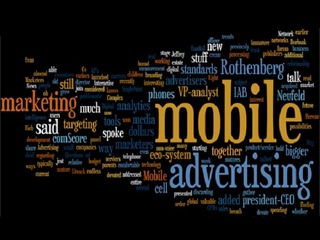
It’s no secret that mobile advertising is key to the future of many Internet giants. Users are going mobile, and advertising is the way that many of these companies stay afloat. A study released by eMarketer projected that mobile ad spending would hit $4 billion in 2012 in the United States alone, an increase of 180% from 2011. That is no small amount of money, and it is only going to rise from there.
Take Facebook, for example. Facebook’s mobile MAUs (monthly active users) were 604 million as of the end of September, an increase of 61% year-to-year, according to its third quarter numbers in October. Facebook will release its fourth-quarter figures on January 30.
The company’s total revenue for that quarter was $1.26 billion, of which $1.09 billion, or 86% of total revenue, came from advertising. It increased 36% from the same quarter in 2011.
Mobile advertising accounts for 20% of all ad spending on Facebook, according to data released by digital marketing software Kenshoo earlier this month. In October, Mark Zuckerberg said that mobile was accounting for 14% of ad spending, meaning the number went up 6% in just four months. While desktop still dominates with 79.7% of dollars spent, it is still pretty impressive considering that there was no such thing as a Facebook mobile advertising less than a year ago, or March 2012, to be exact.
The data also showed that shows that Facebook mobile ads are currently priced at a 70% premium over desktop ads, costing $1.38 a click, compared to 81 cents on desktop.
With data like that, it is easy to see that mobile advertising has become key to the success of the world’s largest social network, as it has for many other big properties, including Yahoo and Zynga.
What works on mobile advertising
So now that we know that mobile advertising is so important, the next logical questions are: how do we optimize it and where is it going?
Mobile devices are extremely personal, Mat Harris, Director of Products at mobile ad network InMobi, said in an interview with VatorNews. “They are always next to you. They are the last things we touch at night, the first things we use in the morning.”
Therefore, he said, the ads that work best are highly relevant to the user, as well as one that call on a user to do something, such as have a call to action, with either a click to download or a click to call. Ads that lend themselves to personalization tend to be the most successful.
In that vein, InMobi recently purchased Overlay Media, a a developer of mobile data analytics based technologies which are designed to improve how marketers and advertisers personalize ads to specific users.
But, even more important than personalization is the ad engaging the user. And that is why InMobi specialized in “rich media” ads. Rich media are flash ads that use the capabilities of the device, including tilt and the ability to play video. By incorporating the features of the device, Harris, said, it creates a deeper, and more fun, experience for the user.
Here is an example of an effective rich media ad on InMobi:
How InMobi measures the successful of a rich media goes beyond just how much times it was clicked.
“Click through rate is not always the goal of a rich media ad. Rich media lends itself to brand advertising, which commonly sets things such as interactions, engagement, video views, etcetera, as objectives. We are seeing a lot of ads with real time data feeds, like scores, stock quotes, and news, and these are performing very well,” Harris said.
As for how to best deploy ads without making people feel like they are getting in the way of the experience, Harris said that this is what developers are constantly working on, including when to employ ads and how often. According to Harris, though, people tend to not mind too much as long as they can easily dismiss the ads.
“The only Ads that seem intrusive are the ones that are not engaging,” he said.
One way that advertisers get a better sense of which ads work, and which do not, Todd Herrold, Senior Director, Product Marketing for Kenshoo Social, is basically by floating a trial balloon.
Brands will put up free ads on their pages, called organic page posts. Generally these are seen by 10 to 15% of people who like that page. Advertisers will then track these links to see how they translate into sales. The more successful of these ads will then become paid ads that are floated to a large audience.
This practice was originally done on desktop, Herrold said, but is now being done on mobile due to the number of Facebook users flocking there.
What other social networks are doing
It’s obviously not just Facebook that has begun to optimize mobile advertising.
In February of 2012, Twitter took its Promoted Posts and Promoted Accounts to mobile, allowing them into mobile timelines. Then, in March, the network said it was going to be launching mobile device targeting, so that brands could increase the prominence and reach of their message to a particular type of mobile user. Some of the brands using targeted Promoted Tweets are American Express, Samsung and Verizon.
Last year, Foursquare got into advertising when it launched Promoted Updates. The way it works is that if a user searches for a location on the social network, they might then get a promoted special about a weekend deal at a nearby store.
What works in gaming
Of course, what works on one aspect on mobile may not work on another, say gaming.
“There has been a shift in how marketers and advertisers gauge the effectiveness of a mobile ad campaign [in gaming],” said Chartboost Chief Revenue Officer Clay Kellog, in an interview. “It’s not just about clicks and eyeballs, but about where people are clicking, and how they engaging with the advertisement to see how they work best. It’s about how long the user session is, how many bootups the game has and how revenue is being gained per user.”
Chartboost offers a platform for mobile game developers to connect and buy advertising from each other directly, meaning that they can skip the mediation and the cut taken out by an ad network.
From the publisher’s standpoint, this has led to a new respect for user experience,where the design of the game is once again important, and developers have become much more receptive to the idea of bringing ads into the game as part of the experience. The developer gets to choose how to display an ad within their own game.
For example, Kellog pointed me toward a game called Hay Day. Part of the game experience requires users to read a newspaper, so for that game the developers decided to stick advertisements for their other games into that paper.
Here is a screenshot of how that works:
 Kellog says that his philosophy is to never break the gameplay up with an ad, even for games that are have continuous action, such as Temple Run. Instead they will be presented at either a break in the gameplay or at the beginning of the session, so that they do not intrude on the user experience.
Kellog says that his philosophy is to never break the gameplay up with an ad, even for games that are have continuous action, such as Temple Run. Instead they will be presented at either a break in the gameplay or at the beginning of the session, so that they do not intrude on the user experience.
The movement toward higher transparency, where developers are given more data to see how they can optimize their games, is leveling the playing field, Kellog said. It is allowing companies to start small and grow, which would have been impossible before.
The future of mobile advertising
Two things that we will see in the future, Herrold said, is the optimization of geo-tagging and the launch of Facebook Exchange onto mobile.
Geo-targeting allows advertisers to send specific ads to users based on their location. For example, if someone is standing in Times Square in New York City, an ad for a specific restaurant, with a coupon, can be sent right to their phone. This is a specific advantage that mobile has over desktop.
In the next few years, geo-targeting will become optimized to correlate with apps that will push location specific deals to people while they are in specific stores, Herrold says.
Herrold also believes that Facebook will launch its Facebook Exchange onto its mobile app.
Facebook Exchange allows marketers to use real-time customer data to reach a larger audience on Facebook. Essentially, if a person visits a website, but does not buy anything, that business can retarget those people the next time they go on Facebook. Right now this feature is only available on the desktop version.
Harris told me that what we are going to see, besides more relevant and personalized ads, are simply better ads. They will be better produced, look more professional and be more fun and engaging.
In the next few years, developers will also figure out how to scale their ads to different platforms, screen sizes, number of pixels and operating systems, he said.
(Image source: http://www.stargroup1.com)


























